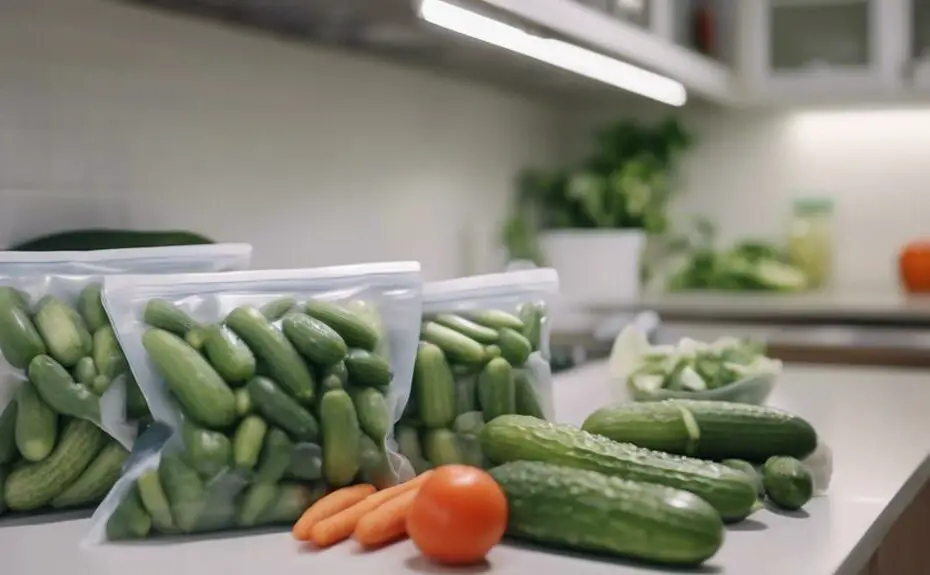As a gardener, I always worry about my cucumbers going to waste. That's why I've discovered the secret to extending their shelf life: vacuum sealing and freezing. By carefully selecting the best cucumbers and using a simple vacuum sealing technique, I've been able to keep them fresh for longer, even beyond the summer season. But there are a few tricks to mastering this preservation method without ending up with mushy cucumbers. Let me guide you through each step so that your cucumbers stay as fresh as the day they were picked.
The first step is to choose the crispest cucumbers for vacuum sealing. Look for cucumbers that are firm and have a vibrant green color. Avoid cucumbers that are soft or have any blemishes or bruises. These flaws can affect the quality of the cucumbers once they are thawed.
Once you have selected the best cucumbers, it's time to vacuum seal them. This process involves removing all the air from the packaging to prevent spoilage. Start by washing and drying the cucumbers thoroughly. Then, slice them into the desired thickness. I recommend slicing them into rounds or spears, depending on how you plan to use them later.
Next, place the cucumber slices into a vacuum-sealable bag or container. Make sure to arrange them in a single layer to ensure even freezing. If you're using a bag, be careful not to overcrowd it. Leave enough space for the vacuum sealer to work its magic.
Once the cucumbers are properly arranged, it's time to seal the bag or container. If you're using a bag, follow the instructions on your vacuum sealer to seal it. If you're using a container, make sure the lid is tightly secured. This step is crucial to prevent any air from entering the packaging.
Now that your cucumbers are properly sealed, it's time to freeze them. Place the sealed bags or containers in the freezer and make sure they are arranged in a way that allows for easy stacking and access. I recommend freezing them in small portions, so you can easily thaw only what you need.
When it's time to use the frozen cucumbers, there are a few important steps to follow. First, make sure to thaw them properly. The best way to do this is by transferring the frozen cucumbers to the refrigerator and letting them thaw slowly overnight. Avoid thawing them at room temperature, as this can cause them to become mushy.
Once thawed, you can use the cucumbers in a variety of dishes. They are perfect for adding a refreshing crunch to salads, sandwiches, and even drinks. You'll be amazed at how well they retain their crispness and flavor, thanks to the vacuum sealing and freezing process.
To get the best results, I recommend using a high-quality vacuum sealer and bags or containers specifically designed for freezing. This will ensure that your cucumbers stay fresh and avoid freezer burn. Some popular vacuum sealers on the market include FoodSaver and NutriChef.
In conclusion, vacuum sealing and freezing cucumbers is a great way to extend their shelf life and enjoy their freshness beyond the summer season. By following the simple steps I've outlined, you can ensure that your cucumbers remain crisp and delicious, ready to be used in a variety of dishes. So don't let your hard-earned cucumbers go to waste anymore – give this preservation method a try and enjoy the taste of summer all year round.
Understanding Vacuum Sealing
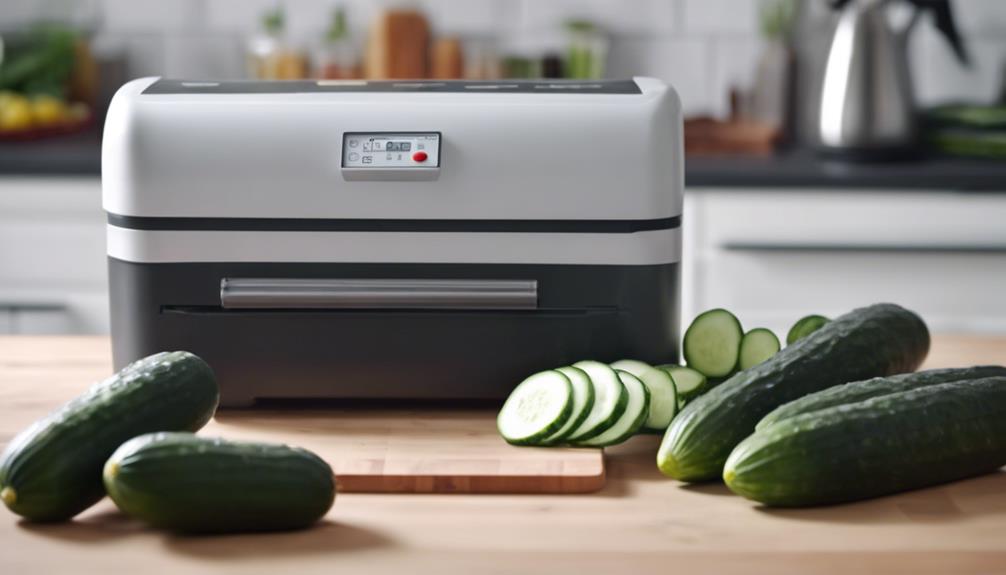
Vacuum sealing is a fantastic way to keep food fresh for longer. It involves removing air from packaging to extend the shelf life of produce like cucumbers. Not only does this technique help us keep food for a longer time, but it also contributes to sustainability by reducing waste.
The process of vacuum sealing is quite simple yet fascinating. I place my cucumbers in a specially designed plastic bag, and with the push of a button, my vacuum sealer removes all the air and seals the bag perfectly. By eliminating the air, this technique slows down the growth of bacteria and mold, which are the main causes of food spoilage.
What I find truly remarkable about vacuum sealing is how it inhibits the oxidation process. Oxidation is a natural occurrence that leads to the deterioration of food, but by removing the air, my cucumbers stay crispy and flavorful for a much longer time compared to their original packaging or simple plastic wrap.
Understanding the science behind vacuum sealing has empowered me to make smarter choices when it comes to preserving food. It's not just about extending the life of my cucumbers; it's about embracing a method that aligns with my commitment to a more sustainable lifestyle.
Benefits of Freezing Cucumbers
Freezing cucumbers is a great way to preserve their freshness and nutritional value for months. It's a method that often gets overlooked, but it has some remarkable benefits that can truly transform your approach to food preservation.
One of the biggest advantages of freezing cucumbers is the extended shelf life it provides. By freezing them, you can enjoy their crispness well beyond their typical season. This means that even in the off-season, you can still have access to delicious and crunchy cucumbers.
Not only does freezing cucumbers extend their shelf life, but it also locks in their vitamins and minerals. This means that you can still reap the health benefits that these veggies offer, even after they've been frozen. So you don't have to worry about compromising on nutrition when using frozen cucumbers in your dishes.
Another great benefit of freezing cucumbers is the convenience it brings. When you have frozen cucumbers on hand, you can easily whip up smoothies or add a refreshing twist to your water without having to make a last-minute trip to the store. It's a time-saving and hassle-free way to incorporate cucumbers into your meals.
By freezing cucumbers, you also contribute to reducing food waste. Instead of letting cucumbers spoil and go to waste, you can save them by freezing them. This not only helps you minimize food waste but also allows you to make the most of your grocery purchases.
Lastly, freezing cucumbers can lead to economic savings. During the peak season, when cucumbers are abundant and more affordable, you can buy them in bulk and freeze them for later use. This way, you can significantly cut down on your grocery bills while still enjoying fresh cucumbers throughout the year.
Incorporating the method of freezing cucumbers into your routine isn't just about preserving cucumbers. It's about embracing a sustainable approach to food preservation that combines convenience, nutrition, and cost-efficiency. So give freezing cucumbers a try and experience the benefits for yourself.
Selecting the Right Cucumbers
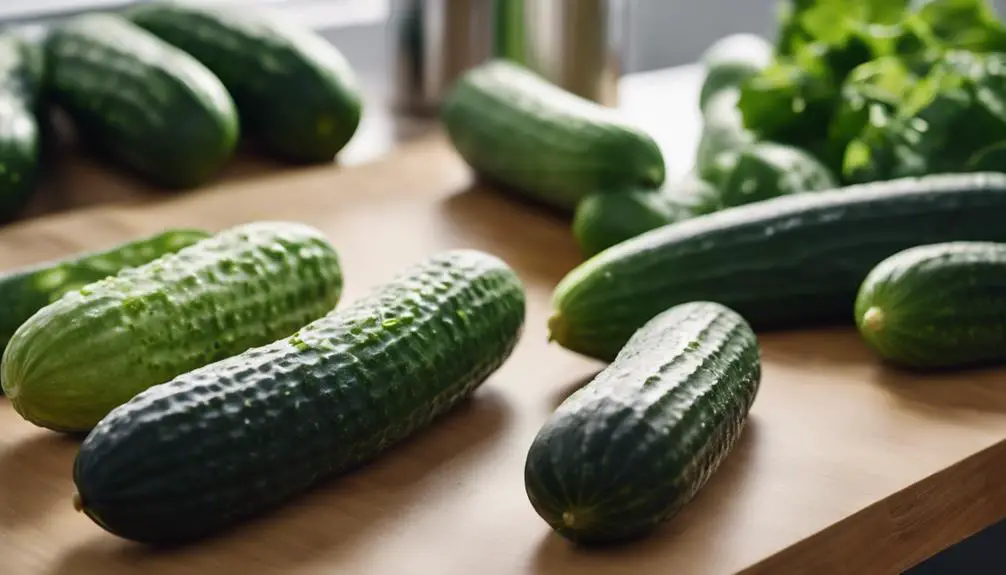
When it comes to freezing cucumbers, selecting the right ones is crucial for preserving their freshness and nutritional value. Not all cucumbers are suitable for freezing, so it's important to pay attention to the details and choose wisely.
Size plays a significant role in freezing cucumbers. Opt for medium-sized cucumbers as they're easier to handle and freeze uniformly. This ensures that you'll have a consistent texture when you thaw them later on. Handling big cucumbers can be a challenge, and smaller ones may not freeze evenly, so medium-sized ones are the ideal choice.
Texture is another important factor to consider. Look for cucumbers that are firm to the touch. This firmness is what helps them retain their crispness even after they've been thawed. Nobody wants a soggy cucumber, so make sure to choose firm ones for the best results.
The color of the cucumbers isn't just an aesthetic consideration; it actually says a lot about their freshness and nutritional content. Bright green cucumbers are a good indication that they're fresh and packed with nutrients. So, when selecting cucumbers for freezing, go for the ones that have a vibrant green color.
Preparing Cucumbers for Freezing
When preparing cucumbers for freezing, it's important to follow a few key steps to ensure they maintain their crispness and flavor. Here's the method I've perfected over time to preserve cucumbers at their peak.
First, start by thoroughly washing each cucumber to remove any dirt or pesticides. This isn't just a quick rinse under the tap. Take the time to use a vegetable brush and gently scrub them under cold running water. This ensures that they're perfectly clean and ready for freezing.
Next, you have the option to peel the cucumbers. While this step is a matter of personal preference, peeling can help achieve a uniform texture once frozen. However, if you prefer to keep the skin on, it can add a nice touch of color and extra nutrients to your frozen cucumbers.
After washing and peeling (if desired), it's time to slice or dice the cucumbers. This step is important for future meal versatility. You can slice them into rounds for sandwiches and salads or dice them for stir-fries. By preparing them in different shapes, you'll have more options when it comes time to use them in your cooking.
Now, let's talk about blanching. Blanching is a crucial step in preserving the vibrant color and crispness of the cucumbers. To blanch the slices or dices, simply immerse them in boiling water for a brief two minutes. This process halts enzyme activity that could otherwise degrade the quality of the cucumbers.
Once the blanching is complete, immediately transfer the cucumbers to a bowl of ice water. This quick cooling process shocks the cucumbers and stops the cooking. It ensures that they maintain their crisp texture and don't become mushy when frozen.
The Vacuum Sealing Process
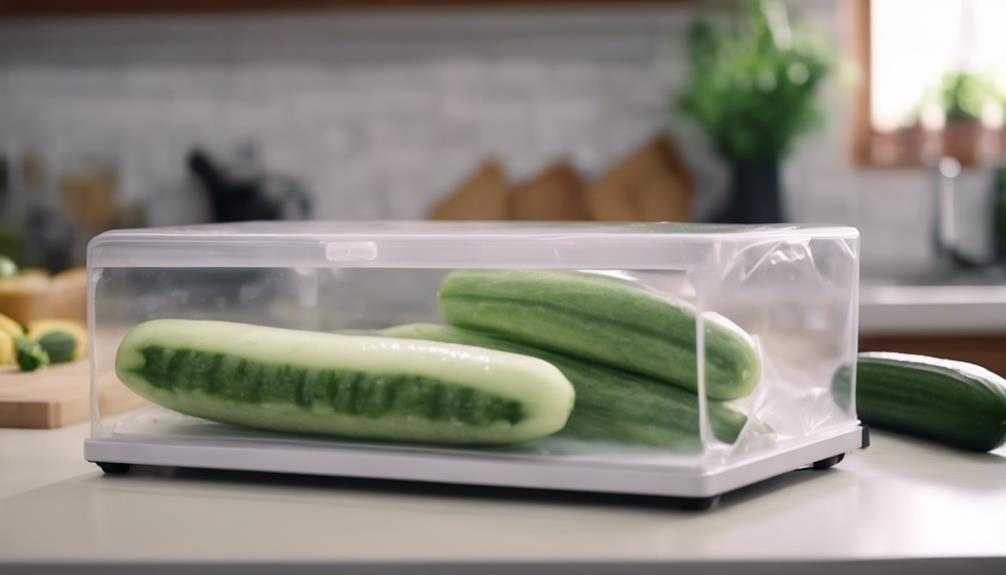
The vacuum sealing process is a game-changer for extending the shelf life of your cucumbers while preserving their flavor and texture. By removing air from the packaging before sealing it, you create an environment that slows down the deterioration process significantly.
To start, it's important to ensure that your cucumbers are completely dry before vacuum sealing them. This helps prevent the formation of ice crystals, which can ruin their texture. Once they're dry, arrange them in a vacuum seal bag so that they freeze individually. This makes it easier to use them in portions later on.
Now, it's time for the vacuum sealer to take center stage. This handy device draws out all the air from the bag and seals it with heat. This process not only extends the shelf life of your cucumbers but also locks in their freshness. When you thaw them later, they'll be as close to garden-fresh as possible.
What I find truly fascinating about vacuum sealing is its simplicity and effectiveness. It showcases how modern technology can be harnessed to keep our food fresher for longer, reducing waste and preserving taste. When combined with freezing, vacuum sealing becomes the ultimate duo for anyone looking to enjoy their harvest well beyond the growing season.
Freezing Your Sealed Cucumbers
Freezing your sealed cucumbers is a fantastic way to preserve their crunch and nutritional value for months. Not only is it incredibly effective, but it's also surprisingly simple. This technique is a game-changer for anyone who wants to enjoy the fresh taste of cucumbers year-round.
Here's how I freeze my cucumbers:
- Pre-chill: Before freezing, I recommend chilling your sealed cucumbers in the fridge for a few hours. This step helps reduce freezer shock and maintains their texture.
- Spacing: Lay the cucumbers out on a baking sheet with enough space between them to freeze individually. This prevents them from sticking together and makes it easier to grab just what you need.
- Temperature: Set your freezer to its lowest setting. The quicker the cucumbers freeze, the better preserved they'll be. This ensures that they retain their crispness and taste when thawed later on.
- Labeling: Don't forget to label each package with the date of freezing. This is important for rotation purposes, as it allows you to use the oldest cucumbers first. It's a simple step that helps you keep track of your frozen cucumber stash.
- Storage: Once the cucumbers are frozen solid, transfer them to a designated area in your freezer. This organization makes it easy to find and manage your stash. You can use freezer bags or containers to keep them neatly organized.
Freezing vacuum-sealed cucumbers is a straightforward process that ensures you can enjoy the crispness and nutritional benefits of cucumbers whenever you desire. Plus, it's a great way to extend the life of your cucumbers and reduce food waste. So go ahead and give it a try!
Thawing and Using Cucumbers
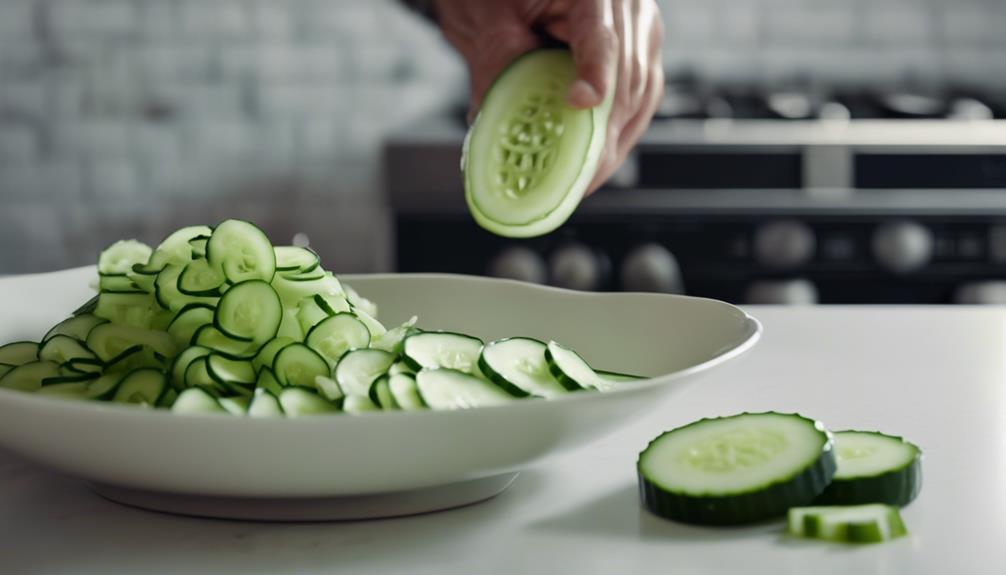
Thawing and Using Cucumbers
If you've successfully frozen cucumbers, it's time to learn the best techniques for thawing them and using them in a way that maintains their flavor and texture. Thawing cucumbers properly is essential, as it's not as simple as waiting for them to defrost. There's an art to it that ensures your cucumbers are as close to their fresh state as possible.
Here's a quick guide to thawing cucumbers:
- Refrigerator Method: Thawing cucumbers in the refrigerator is the most gentle method and is perfect for preserving their texture for salads and cold dishes. Simply place the frozen cucumbers in a covered container and let them thaw for about 24 hours. This method ensures that the cucumbers retain their crispness and are ready to be used in refreshing salads or other chilled dishes.
- Cold Water Bath Method: If you're short on time and need to thaw your cucumbers quickly, a cold water bath is the way to go. Fill a large bowl with cold water and submerge the frozen cucumbers in it. Let them sit for 2-3 hours, making sure to stir occasionally. This method maintains the texture of the cucumbers while allowing them to thaw faster. However, be careful not to leave them in the water for too long, as they can become waterlogged and lose their crunch.
- Room Temperature Method: It isn't recommended to thaw cucumbers at room temperature. Doing so can make the cucumbers soggy and affect their taste and texture. It's best to avoid this method altogether to ensure the quality of your cucumbers.
Once your cucumbers are thawed, it's time to put them to good use. While their texture may be slightly altered after freezing, there are still plenty of delicious dishes you can create with them. Embrace their new state and experiment with recipes that highlight their unique characteristics. Here are a few ideas:
- Smoothies: Use thawed cucumbers to add a refreshing twist to your favorite smoothie recipes. Their slightly softer texture blends well and adds a cool, crisp flavor to your drink.
- Gazpacho: Thawed cucumbers are perfect for making gazpacho, a chilled Spanish soup. Their tender texture blends smoothly with other ingredients like tomatoes, peppers, and herbs, creating a refreshing and flavorful dish.
- Cucumber Soup: Create a creamy and refreshing cucumber soup by pureeing thawed cucumbers with yogurt, herbs, and spices. This light and refreshing soup is perfect for hot summer days.
Tips for Long-Term Storage
To ensure your cucumbers stay fresh and delicious for as long as possible, it's important to follow proper long-term storage techniques. Here are some tips to help maximize the shelf life of your cucumbers:
- Prep Before Storage: Before storing your cucumbers, make sure to wash them thoroughly to remove any dirt or bacteria. It's also important to dry them completely to prevent the formation of ice crystals during freezing.
- Vacuum Seal: Investing in a good vacuum sealer can make a big difference in preserving the quality of your cucumbers. By removing as much air as possible from the storage bag, you can prevent freezer burn and retain the crisp texture of the cucumbers.
- Flash Freeze: To prevent your sliced cucumbers from sticking together, it's best to flash freeze them before transferring them to a vacuum-sealed bag. Simply lay the sliced cucumbers on a baking sheet, making sure they're not touching, and freeze them for a few hours. This will help maintain their individual pieces.
- Label Clearly: Always remember to write the date of freezing on your storage bags. This way, you can easily keep track of the optimal freshness period, which is typically around 8-12 months. By using the cucumbers within this timeframe, you can ensure the best taste and quality.
- Optimal Temperature: Maintaining a constant temperature in your freezer is essential for preserving the cucumbers. Fluctuations in temperature can accelerate spoilage, so it's important to keep the freezer at the recommended setting.
Common Mistakes to Avoid
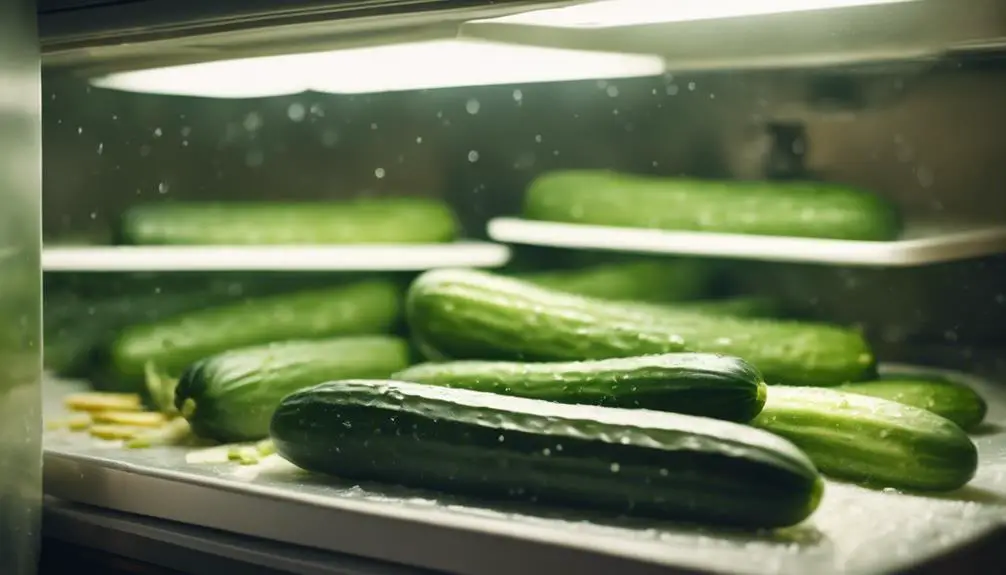
When it comes to preserving cucumbers for the long haul, it's important to avoid common mistakes that can compromise their quality and taste. I've learned these lessons through trial and error, and now I've a foolproof approach to keeping cucumbers fresh for months on end. Let's take a closer look at the mistakes to avoid, so your cucumbers stay as delightful as the day you picked or bought them.
One common mistake to avoid is skipping the blanching process. Blanching is important because it stops the enzymes from degrading the texture and flavor of the cucumbers. Without blanching, you'll end up with a mushy disappointment.
Another mistake to avoid is overpacking the bags when you freeze the cucumbers. This prevents proper vacuum sealing and can lead to freezer burn and ice crystals, which can ruin the texture of the cucumbers.
Don't ignore dryness when freezing cucumbers. If there's moisture on the cucumber surface before freezing, it can cause ice formation. This significantly affects the texture of the cucumbers when you thaw them.
Frequently Asked Questions
Can I Vacuum Seal and Freeze Cucumbers Without Removing the Seeds?
Absolutely! You can definitely vacuum seal and freeze cucumbers without removing the seeds. This method is a game-changer when it comes to preserving their freshness. By vacuum sealing, you create an airtight environment that locks in the flavor and nutrients, making it a fantastic way to extend the shelf life of cucumbers.
When you freeze cucumbers with their seeds intact, you don't have to worry about sacrificing any of the nutritional benefits. The seeds are packed with fiber and contain valuable vitamins and minerals. So, by keeping the seeds in, you're maximizing the nutritional value of the cucumbers.
To vacuum seal and freeze cucumbers, start by washing them thoroughly to remove any dirt or debris. Then, pat them dry with a towel. Next, slice the cucumbers to your desired thickness. You can go for thin slices if you plan to use them in salads or thicker slices if you want to use them in smoothies or soups.
Once the cucumbers are sliced, place them in a vacuum-sealable bag. Make sure to spread them out in a single layer, so they freeze evenly. If you want to keep them from sticking together, you can place a piece of parchment paper between the cucumber slices.
Before sealing the bag, it's a good idea to remove as much air as possible. You can do this by using a vacuum sealer or by manually removing the air using a straw. Once the bag is sealed, label it with the date and contents.
Now, you're ready to freeze the cucumbers. Lay the bags flat in the freezer, making sure they are not stacked on top of each other. This way, they will freeze faster and be easier to store.
When you're ready to use the frozen cucumbers, simply thaw them in the refrigerator overnight or for a few hours at room temperature. They will retain their crispness and flavor, making them perfect for salads, smoothies, or any other recipe that calls for fresh cucumbers.
How Does the Texture of Cucumbers Change After Vacuum Sealing and Freezing?
After freezing, cucumbers undergo a noticeable transformation. They become softer and more waterlogged, losing their crispness and fresh texture. This change makes them less suitable for salads, where a crunchy texture is desired. However, they can still be used effectively in smoothies or soups, where their softened texture can add a refreshing and hydrating element.
When cucumbers are vacuum sealed and frozen, the low temperature causes the water inside the cucumbers to freeze and expand. This expansion leads to cell damage, resulting in a loss of firmness and a softer texture. Additionally, the freezing process breaks down the cell walls, releasing more water and making the cucumbers appear waterlogged.
While the texture of frozen cucumbers may not be ideal for certain dishes, they can still be used in creative ways. For example, they can be blended into smoothies to add a cool and refreshing element. Their softened texture blends easily, creating a smooth and creamy consistency.
In soups, frozen cucumbers can act as a natural thickener and provide a subtle flavor. They can be added to vegetable-based soups or pureed for a creamier texture. The water content in frozen cucumbers can contribute to the overall liquid volume of the soup, creating a more hydrating and satisfying dish.
It's important to note that while the texture of frozen cucumbers may change, their nutritional value remains largely intact. Cucumbers are low in calories and a good source of vitamins and minerals. Freezing them allows you to enjoy their benefits even after their peak freshness.
Are There Any Safety Concerns With Vacuum Sealing Cucumbers at Home?
When it comes to vacuum sealing cucumbers at home, safety should always be a top priority. It is important to thoroughly wash and dry the cucumbers before sealing them to prevent the growth of bacteria. This step is crucial in ensuring that you and your family are not exposed to any harmful pathogens.
While vacuum sealing cucumbers can be a bit tricky at first, it is definitely worth taking the time to master the technique. By removing the air from the packaging, you can extend the shelf life of the cucumbers and keep them fresh for a longer period of time. This can be particularly useful if you have a surplus of cucumbers from your garden or if you want to take advantage of a good deal at the grocery store.
To vacuum seal cucumbers at home, you will need a vacuum sealer machine and vacuum-sealable bags or containers. It is important to choose cucumbers that are firm and free from any signs of spoilage. Wash the cucumbers thoroughly under running water to remove any dirt or contaminants. Pat them dry with a clean towel to ensure that no moisture remains.
Next, you can either slice the cucumbers or leave them whole, depending on your preference. If you choose to slice them, make sure to cut them into uniform pieces to ensure even sealing. Place the cucumbers into the vacuum-sealable bags or containers, leaving some space at the top for the seal.
Now, it's time to use your vacuum sealer machine. Follow the manufacturer's instructions to properly seal the bags or containers. Make sure that the seal is tight and secure to prevent any air from entering. If you are using bags, you can also double-seal them for added protection.
Once the cucumbers are vacuum sealed, store them in the refrigerator to maintain their freshness. It is recommended to consume vacuum-sealed cucumbers within a week for optimal quality. If you notice any signs of spoilage, such as a foul odor or mold, discard them immediately.
Can Vacuum-Sealed and Frozen Cucumbers Be Used in Fresh Salads Upon Thawing?
Using vacuum-sealed and frozen cucumbers in fresh salads may not yield the best results. Thawed cucumbers tend to become mushy, which can compromise the texture and overall enjoyment of the salad. However, there are alternative ways to use these cucumbers that can still be delicious and satisfying.
One option is to incorporate the thawed cucumbers into smoothies. Their soft texture works well when blended with other ingredients like fruits, yogurt, and ice. This can add a refreshing twist to your smoothie and still allow you to enjoy the flavors of the cucumbers.
Another option is to use the thawed cucumbers in cooked dishes. Whether it's a stir-fry, a pasta dish, or a sautéed vegetable medley, the softness of the cucumbers can blend well with other ingredients and create a unique flavor profile. Just be mindful of the cooking time to avoid overcooking the cucumbers and losing their freshness.
While it may be disappointing that thawed cucumbers don't work well in fresh salads, there are still plenty of other ways to incorporate them into your meals. Experimenting with different recipes and cooking techniques can help you discover new and delicious ways to enjoy these cucumbers.
When it comes to specific product recommendations, it's important to choose high-quality vacuum-sealed cucumbers that have been properly frozen. This ensures that the cucumbers retain their flavor and nutrients. Look for reputable brands that prioritize freshness and quality.
How Do I Handle Vacuum-Sealed Cucumbers That Have Accidentally Been Left Out of the Freezer Overnight?
If I accidentally leave vacuum-sealed cucumbers out overnight, I will first check for any signs of spoilage. I will look for any changes in appearance or smell that may indicate that the cucumbers have gone bad. If they still look and smell fine, I will immediately refrigerate them to ensure their freshness. However, if there is any doubt or uncertainty about their safety, it is best to err on the side of caution and discard them. It's always better to be safe than sorry when it comes to food safety.
Conclusion
In my quest to keep cucumbers crisp and crunchy, I've discovered a simple solution: vacuum sealing and freezing. These techniques not only preserve the cucumbers but also ensure they maintain their peak freshness for months to come. When you thaw these cucumbers, they undergo a delightful transformation, becoming tender and tantalizing. This makes them perfect for adding to punches or creating flavorful purees. By following the right routine, you can avoid any mistakes and enjoy the success of having splendidly stored cucumbers. Let me guide you through the process.
To begin, let's simplify the language and use clear, concise terms. Instead of saying 'conquer the conundrum,' we can say 'solve the problem.' This makes it easier for readers to understand the purpose of vacuum sealing and freezing cucumbers.
Next, we need to avoid cliches and overused words. Instead of saying 'magic of vacuum sealing,' let's say 'benefits of vacuum sealing.' This way, we focus on the practical advantages rather than using a cliched phrase.
Now, let's provide more context and explain why vacuum sealing and freezing are important. These techniques not only extend the shelf life of cucumbers but also help retain their crispness and crunchiness. By removing air from the packaging, vacuum sealing prevents the cucumbers from being exposed to moisture and oxygen, which can cause them to spoil quickly. Freezing, on the other hand, helps to preserve the cucumbers at their peak freshness, allowing you to enjoy them months later.
In terms of transitions, let's create a natural flow based on the context. For example, we can say, 'In addition to preserving the cucumbers, vacuum sealing and freezing also enhance their flavor and texture. When you thaw these cucumbers, they become tender and tantalizing, ready to be used in a variety of dishes.'
Using active voice instead of passive voice can also improve clarity. For instance, instead of saying 'Thawed, they're transformed,' we can say 'When you thaw them, they transform.' This way, it's clear that the action is being performed by the reader.
Including specific examples and product recommendations can make the information more helpful. For instance, you can mention specific vacuum sealing machines or freezer bags that work well for cucumbers. This adds a practical element to the text and helps readers make informed decisions.
Lastly, let's correct any spelling and grammar errors to ensure the text is polished and professional. This will enhance readability and maintain the credibility of the information.
In conclusion, vacuum sealing and freezing cucumbers is a simple yet effective way to extend their shelf life and preserve their crispness. By following these techniques, you can enjoy fresh cucumbers for months. Remember to choose high-quality vacuum sealing machines and freezer bags for optimal results. With the right routine and attention to detail, you can savor the success of splendidly stored cucumbers in your culinary endeavors.
